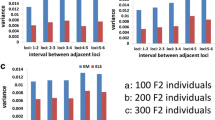Abstract
“Resolving power” is defined as the 95% confidence interval for quantitative trait locus (QTL) map location that would be obtained when scoring an infinite number of markers in a given constellation of a marker-QTL mapping experiment. Resolving power can serve as a close estimate of the confidence interval of QTL map location, as well as a guide to the lower efficient limit of marker spacing in an initial marker-QTL mapping experiment. In the present study, an extensive series of simulations was carried out to provide estimates of resolving power, for backcross (BC) and F2 designs, over a wide range of experimental sizes and of gene effects and dominance at the QTL. From the simulation results, the remarkably simple expressions, 3000/(mNd 2) (where m = 1 for BC and m = 2 for F2; N = population size, and d = allele substitution effect) and 530/Nν (in terms of ν, the proportion of variance explained), were obtained for estimating resolving power. These expressions can provide a convenient guide to planning marker spacing in BC and F2 marker-QTL linkage experiments and for placing confidence intervals about QTL map location obtained in such experiments.
Similar content being viewed by others
REFERENCES
Darvasi, A., Weinreb, A., Minke, V., Weller, J. I., and Soller, M. (1993). Detecting marker-QTL linkage and estimating QTL gene effect and map location using a saturated genetic map. Genetics 134:943–951.
Falconer, D. S. (1989). Introduction to Quantitative Genetics, 3rd ed., Longman, New York.
Hoeschele, I., and Van Raden, P. M. (1993). Bayesian analysis of linkage between genetic markers and quantitative trait loci. 1. Prior knowledge. Theor. Appl. Genet. 85:953–960.
Lander, E. S., and Botstein, D. (1989). Mapping mendelian factors underlying quantitative traits using RFLP linkage maps. Genetics 121:185–199.
Mangin, B., Goffinet, B., and Rebai, A. (1994). Constructing confidence intervals for QTL location. Genetics 138:1301–1308.
Rebai, A., Goffinet, B., and Mangin, B. (1994). Approximate thresholds of interval mapping tests for QTL detection. Genetics 138:235–240.
Thoday, J. M. (1961). Location of polygenes. Nature 191:368–370.
Van Ooijen, J. W. (1992). Accuracy of mapping quantitative trait loci in autogamous species. Theor. Appl. Genet. 84:803–811.
Visscher, P. M., Thompson, R., and Haley, C. S. (1996). Confidence intervals in QTL mapping by bootstrapping. Genetics 143:1013–1020.
Author information
Authors and Affiliations
Corresponding author
Rights and permissions
About this article
Cite this article
Darvasi, A., Soller, M. A Simple Method to Calculate Resolving Power and Confidence Interval of QTL Map Location. Behav Genet 27, 125–132 (1997). https://doi.org/10.1023/A:1025685324830
Issue Date:
DOI: https://doi.org/10.1023/A:1025685324830




